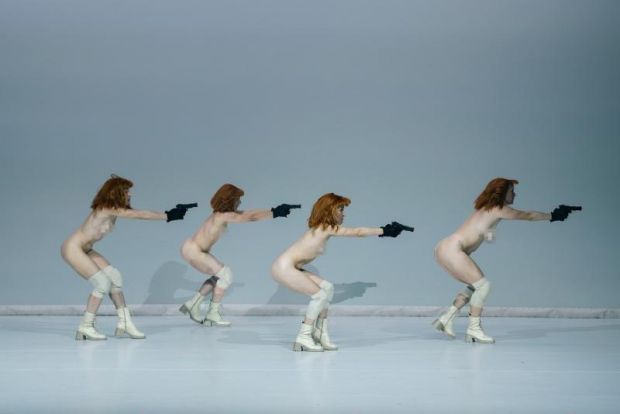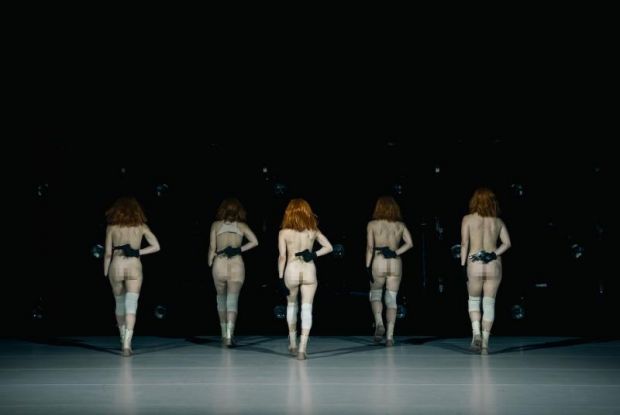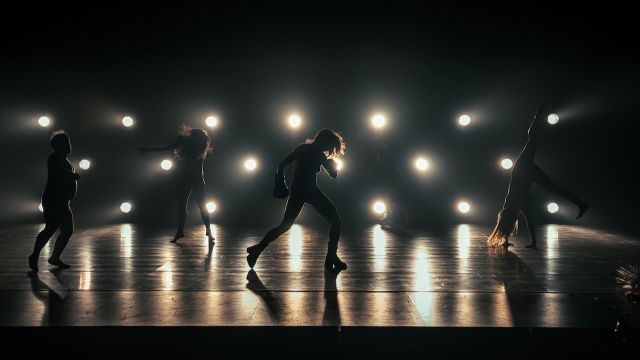Kill Me
The poster for Kill Me – three naked red-haired women in profile with guns – is provocative, sexy and intriguing. Is that going to be on stage? Yes, it is. In fact, there are five naked women with guns and that image is central both to the strengths, but also perhaps the less successful aspects of this complex show.
Kill Me, is the work of Argentinian choreographer, writer, theatre maker and video diarist Marina Otero. She is also one of the five dancers. Her show combines resonant images, video, dance, satire, confessional autobiography and political protest. The perfectly calculated light design is by Victor Longas Vicente and David Seldes.

The show begins unexpectedly with some video diary - autobiography projected on a huge screen – as if we’ve come to a movie. Ostensibly shot by Otero (but not all of it can be), it is chaotic and reflects the chaos, and manic despair of her life. She is still getting over Pablo (subject of her 2024 show Love Me) the lover who dumped her. Even after she had read his diaries and discovered that he thought her intelligence inferior to his, she had stayed with him two more years. That confession of enduring two more years of humiliation – that of the helpless woman trapped in her own desires – is a powerful theme or thread – tragic or comic - that runs through this show and holds it together.
The cinema-size screen is lifted, and a bright white space is revealed, into which comes the line of the five red-wigged women – with their pistols, naked but for clunky white boots and knee guards - dancing in sync across and around the stage. Some people have been reminded of the silhouettes in the credit sequences of Bond movies. I also thought of those Robert Palmer 1980s rock clips, with their lines of blank-faced, conventionally ‘beautiful’ models all moving in sync. With Kill Me, we’ve seen the poster, so we know this is coming, but it is still a touch shocking – but it’s also funny. The choreography is simple, even slightly naff, but choreography isn’t the point. The nakedness is a form of satire. Naked, not nude’. Nudity doesn’t come into it. The naked bodies make a statement – of both a vulnerability and a no frills, matter-of-fact quality – paradoxically a counter to the ‘male gaze’.

In a second sequence, the five women adopt different poses, pointing their guns, shooting their guns – like action movie heroines (Sarah Connor in the Terminator movies gets a reference later) – but also being shot by guns, writhing in agony and dying. It’s funny, it’s exaggerated and ridiculous – all the more so because of the nakedness.
Body image is central to Kill Me. On a stage bare except for one of the dancers, Myriam Hedde-Adda, now at a grand piano, comes a small, balding, middle-aged and paunchy guy who claims to be Vaslav Nijinsky reincarnate. He dances (badly) to prove it. Again, it’s funny, it’s ridiculous – and it’s pointed. When the ensemble returns, this little guy (Tomás Pozzi) is included – with his own red wig and knickers adorned with a strip of pubic hair – like the women...

Marina Otero says, ‘Let’s say the topic [of Kill Me] is about mental health, so it enters the inclusive agenda of the art market.’ The sarcasm of that aside, Otero was diagnosed as bipolar and is now permanently on lithium (she tells us). So, she has recruited four bipolar (she thought) dancers for her show. Bipolar or not, all are beautiful dancers with dancers’ bodies. As the red wigs come off and some bodies are semi-clothed, Kill Me shifts gear into confessional mode with each of these women, beginning with Otero herself, telling their stories of their losses, miseries, humiliations, and what they did to resist. Drugs, lots of rough sex, or surviving like – and singing like – Edith Piaf, wearing boxing gloves like the boxer lover Piaf lost – this woman shadow boxes in a boiling rage...
Here the show veers a little close to ‘poor me’ self-pity and whining but it’s lifted, first, by one woman confessing, with some embarrassment, that she’s not bipolar, her only connection to mental illness being that her parents are Lacanian psychotherapists – and only let in because she can roller skate – which she does with great skill as she whizzes around the stage.

Second, most poignant and most entertaining, is the confession of the tallest, most rounded of the women, Myriam Henne-Adda. While dancing, naked but on point, on-axis and off-axis, a perfectly trained classical dancer, she tells of wanting her whole life to be a ballerina, but she just has the wrong body. The point is emphasised by her dancing with little Pozzi – her humiliation aggravated, as she says, by having to ‘dance with a dwarf!’ The audience winces, and so does he, but we get it. Their attempts at several pas de deux – doomed to fail – are, like so much in Kill Me, ludicrous and impossibly sad. Here the themes of body image, satire, double standards, discrimination and unjust expectations all come together.

Otero tells us that she has no children, no partner, but to go on living she’ll do the only thing she can do: make theatre. She’s discovered she can do what she likes -which may or may not be a good thing. What she’s made here is startling, funny, truthful, sometimes awkward, sometimes cheesy, and a bit of a grab bag of ideas and preachy statements. But her images are complex, strong and unforgettable – and what she and her cast are saying to us is undoubtedly truthful even if just a little self-serving and self-pitying. As The Companion remarked, after the show, ‘Half brilliant, half bullshit.’
Michael Brindley
Images: Marina Caputo - @anima__marina
Subscribe to our E-Newsletter, buy our latest print edition or find a Performing Arts book at Book Nook.

